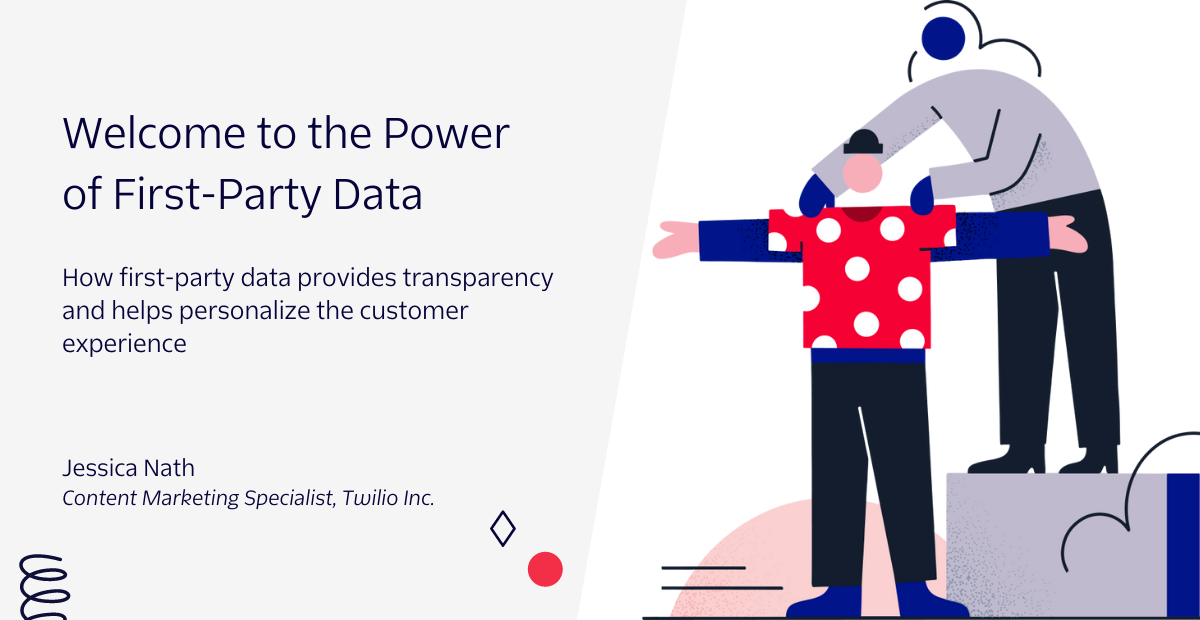Welcome to the Power of First-Party Data
Time to read: 4 minutes

How first-party data provides transparency and helps personalize the customer experience
Think about how much marketing you absorb each day. No, really—think about it. Break it down to even just your morning:
You wake up and check the weather on your phone—on a website plastered with advertisements. Then, you turn on the news while you get dressed—just in time for the segment on the best lotions to add to your skincare routine. “Ding!” That’s your cellphone with an email notification informing you of your favorite store’s latest promotion.
Every day, the average person is inundated with marketing tactics. It’d be impossible to take in every marketing tactic thrown our way.
So, as a marketer, how can you effectively break through all this noise? And, even more importantly, how can marketers increase customer loyalty, especially during a time of so much change?
To learn how marketers can navigate consumers’ demands for personalization, transparency, and the upcoming end to third-party cookies, we spoke with the following Twilio experts:
Personalization is the future of marketing
Eighty-three percent of consumers reported an increase in loyalty to a company that offers them a personalized experience, according to Twilio’s State of Customer Engagement Report, 2022. And most companies believe they are creating that personalized experience their customers desire. However, that’s likely not the case—just 48% of consumers in our survey said they are getting “good” or “excellent” personalization from brands.
So, what can marketers do?
The first step to creating a personalized customer experience is to fully understand your customers.
“If your customers are giving you all sorts of information by what they click on, what they don’t click on, what they scroll through, what they scroll past, what they buy, what they return, etc. and you’re not using that information to make smarter decisions for customers, then you are at a competitive disadvantage,” Lawson said.
All of that rich customer data you collect through your customers’ interactions with your business, such as your website or app, is called first-party data. And it's the key to creating standout personalized experiences.
It’s vital to collect all of that data to fully understand who your customers are and what they really want from you. Then, you can create customer profiles and personalize your marketing across their journeys. A few examples of this could include:
- Delivering a personalized dashboard when they log onto your website, showing customers items they’ve already viewed or similar items that might interest them
- Adding a free product that you know they’ll like within their delivery
- Sending an email to let them know the item they recently viewed is on sale (if they’ve opted in for email, of course!)
The possibilities for personalization are endless.
Strengthen customer trust with data security
Personalized experiences help with customer loyalty, but that loyalty will only grow if the company also builds trust.
Gone are the days when customers blindly trust that a company will protect their data. In fact, our State of Customer Engagement Report, 2022, showed that while 95% of B2C companies believe customers trust them with their data, only 65% of customers actually do.
Data security and privacy are more easily accomplished with the right type of data. According to Wong, that is first-party data.
“Given the growing shift to privacy and the increasing need to personalize, companies need to adjust their marketing strategies to focus on first-party data,” said Wong. “The phasing out of third-party cookies actually presents advertisers with a great opportunity to rebuild consumer trust using first-party data.”
With first-party data, your company is collecting information directly from customers, with their consent. This is advantageous in many ways but only if you are also transparent with this data.
And this is especially true now with the looming end to third-party cookies, which will deeply affect both personalization and data privacy.
It’s time to prepare for the end of third-party cookies
Our State of Customer Engagement Report, 2022, showed that more than half of organizations don’t feel fully prepared for a cookieless future. So how can marketers ensure they’re ready by Google’s late 2023 deadline?
The only way to move forward with the end of third-party cookies is to rely on first-party data. That means the only data you collect on your customers is from their direct interactions with your company.
With third-party cookies leaving the party, you can no longer buy another company’s data. And while this transition might feel frustrating, it will help your company in the long run, according to Weinstein.
“This is the time to prepare,” Weinstein said. “Whoever moves now, gets first-mover advantage, gets the big marketing ROI. And if you wait, we do think you’ll regret it.”
Marketing changes are looming
By late 2023, it doesn’t matter if you are ready or not—third-party cookies will no longer exist. That means big changes to personalization as well as data privacy and transparency. But it also means a big opportunity for your company to adjust your personalization and data privacy tactics in ways that will increase customer loyalty and trust.
Show your customers you care about what is truly important to them. Now is the time to transition from reliance on third-party cookies to first-party data.
Jessica Nath is a Content Marketing Specialist at Twilio Inc. If there are any misspellings in her posts, it's due to her cat, Joepie, sauntering across her keyboard. She can be reached at jnath [at] twilio.com.
Related Posts
Related Resources
Twilio Docs
From APIs to SDKs to sample apps
API reference documentation, SDKs, helper libraries, quickstarts, and tutorials for your language and platform.
Resource Center
The latest ebooks, industry reports, and webinars
Learn from customer engagement experts to improve your own communication.
Ahoy
Twilio's developer community hub
Best practices, code samples, and inspiration to build communications and digital engagement experiences.

